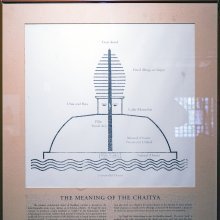Munti, Muṇṭi, Munṭī: 3 definitions
Introduction:
Munti means something in Hinduism, Sanskrit, Tamil. If you want to know the exact meaning, history, etymology or English translation of this term then check out the descriptions on this page. Add your comment or reference to a book if you want to contribute to this summary article.
Images (photo gallery)
In Hinduism
Shilpashastra (iconography)
Source: Shodhganga: The significance of the mūla-beras (śilpa)Munti is the name of a Gaṇa depicted in the Adi Kumbeswarar Temple (Ādi Kumbheśvara) in Kumbakonam (Kumbhakonam), representing a sacred place for the worship of Śiva.—The mūla-bera of the Ādi Kumbheśvar temple is liṅga. In the garbhagṛha, there is a liṅga with two Gaṇas named Danti and Munti.

Shilpashastra (शिल्पशास्त्र, śilpaśāstra) represents the ancient Indian science (shastra) of creative arts (shilpa) such as sculpture, iconography and painting. Closely related to Vastushastra (architecture), they often share the same literature.
Languages of India and abroad
Tamil dictionary
Source: DDSA: University of Madras: Tamil LexiconMuṇṭi (முண்டி) noun < Hindi muṇḍa. [Telugu: muṇḍi, K. moṇḍu.] Pertinacious beggar. See கல்லுளிமங்கன். [kallulimangan.] Local usage
--- OR ---
Muṇṭi (முண்டி) noun < muṇḍin.
1. Person with a clean-shaven head; மழித்த தலையினன். (திருவாலவாயுடையார் திருவிளையாடற் குறிப்பு.) [mazhitha thalaiyinan. (thiruvalavayudaiyar thiruvilaiyadar kurippu.)]
2. Barber; நாவிதன். (இலக்கியச் சொல்லகராதி) [navithan. (ilakkiyas sollagarathi)]
3. cf. puṇḍrin. One who wears a caste mark on his forehead; நெற்றியில் திரி புண்டரம் அணிந்தவன். நீற்றுப் பூண்டகு முண்டி யேடா [nerriyil thiri pundaram aninthavan. nirrup pundagu mundi yeda] (திருவாலவாயுடையார் திருவிளையாடற் [thiruvalavayudaiyar thiruvilaiyadar] 13, 14).
--- OR ---
Muṇṭi (முண்டி) [muṇṭittal] 11 transitive verb < muṇḍa. To shave the head completely; மொட்டை யாய்ச் சிரைத்தல். தலை முண்டிக்கு மொட்டரை [mottai yays siraithal. thalai mundikku mottarai] (தேவாரம் [thevaram] 423, 4).
--- OR ---
Muṇṭi (முண்டி) noun See முண்டனி. [mundani.] (நாமதீபநிகண்டு [namathipanigandu] 329.)
--- OR ---
Munti (முந்தி) < முந்து-. [munthu-.] noun
1. Front; முன்னிடம். [munnidam.]
2. See முந்தானை. பொதுமாதர் முந்தி யே தொடு மிடங்கள் [munthanai. pothumathar munthi ye thodu midangal] (திருக்குற்றாலத் தல மந்தமா. [thirukkurralath thala manthama.] 21). — adverb Some time before; முற்காலம். முந்தி வானோர்கள் வந்து [murkalam. munthi vanorkal vanthu] (தேவாரம் [thevaram] 477, 8).
Tamil is an ancient language of India from the Dravidian family spoken by roughly 250 million people mainly in southern India and Sri Lanka.
Nepali dictionary
Source: unoes: Nepali-English DictionaryMunṭī (मुन्टी):—n. small size of मुन्टो [munṭo]
Nepali is the primary language of the Nepalese people counting almost 20 million native speakers. The country of Nepal is situated in the Himalaya mountain range to the north of India.
See also (Relevant definitions)
Starts with: Mumtidu, Mumtikku, Munticinor, Muntikkarukkal, Muntinu, Muntir, Muntira, Muntiram, Muntiri, Muntiri-p-palam, Muntirikai, Muntirikkottai, Muntiriyana, Muntitai, Muntitam, Muntiviri, Muntiyavatti.
Query error!
Full-text (+16): Mundi, Mahamundi, Mundikalpa, Nirrumunti, Melmunti, Atimunti, Muntiviri, Muntikkarukkal, Coti-munti, Gorkh-mundi, Zinki-mundi, Mundi gedde, Nar-mundi, Aane mundi, Mundi mara, Mokanai, Mumdikasa, Venkanan, Jaganniyanta, Goura-mundi.
Relevant text
Search found 37 books and stories containing Munti, Mundi, Munthi, Muṇṭi, Munṭī; (plurals include: Muntis, Mundis, Munthis, Muṇṭis, Munṭīs). You can also click to the full overview containing English textual excerpts. Below are direct links for the most relevant articles:
Temples of Purushottama Kshetra Puri (by Ratnakar Mohapatra)
1. Vimala Temple (in Puri) < [Chapter 6 - Shakta Temples of Purushottama Kshetra]
2. Jagannatha Temple architecture (2): The Jagamohana or Mukhasala < [Chapter 3 - Lord Jagannatha Temple]
2. Jagannatha Temple architecture (1): The Vimana < [Chapter 3 - Lord Jagannatha Temple]
Notices of Sanskrit Manuscripts (by Rajendralala Mitra)
Page 222 < [Volume 6 (1882)]
Tiruvaymoli (Thiruvaimozhi): English translation (by S. Satyamurthi Ayyangar)
Pasuram 8.5.7 < [Section 5 - Fifth Tiruvaymoli (Mayak kutta)]
International Ayurvedic Medical Journal
A critical review of mundi (sphaeranthus indicus linn) < [2018, Issue VI, June]
Effect of mundi and nirgundi on vishaada (depression) – a literary review < [2019, Issue 10, October]
A comparative study on the role of yogavasti (kshar vasti and saindhavadi taila) and amritadi churna in the management of amavata (rheumatoid arthritis) < [2017, Issue VI June]
Journal of Ayurveda and Holistic Medicine
Phyto-pharmacognostical study of mundi (sphaeranthus indicus linn.) < [Volume 2, issue 2 (2014)]
Ayurvedic approach in Infertility due to PCOS (Anovulatory cycle) a single case study < [Volume 11, issue 4 (2023)]
A review on Priya Nighantu < [Volume 12, issue 8 (2024)]
Jainism in Odisha (Orissa) (by Ashis Ranjan Sahoo)
Structural Architecture < [Chapter 4]
Jaina Antiquities at Budhapada (Khordha) < [Chapter 3: Survey of Jaina Antiquities in Odisha]
The Jaina Temple of Choudhury Bazar, Cuttack City < [Chapter 3: Survey of Jaina Antiquities in Odisha]
Related products


